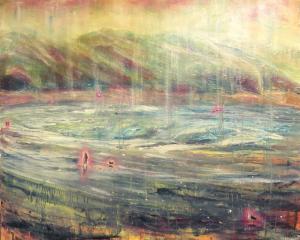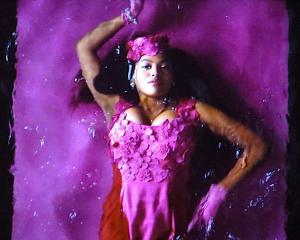This week, ODT art critic James Dignan looks at works by the group Uniform, a collaboration between Pip Marshman and Karin Tierney, and another collaboration between Michael Greaves and Georgia Glass.
Uniform is a loose collective of women artists who have created a symbolic bridge between the underground creative scene of Dunedin and Auckland with a series of exhibitions, events, and "no venue'' happenings in the two cities.
May is New Zealand Music Month. As such, Uniform's exhibition at Blue Oyster is perfectly timed. The display is informed by Kiwi rock and partakes of the do-it-yourself, not-entirely-serious ethos with which the classic 1980s era of Dunedin and Auckland music was infused.
The work, with its manifesto of "taking back the car parks'' and "doing something right now without asking first'' surreptitiously hidden away at the back of the exhibition, can be likened to a three-dimensional fanzine.
The bold monochromatic images have a strong feeling of the ephemeral, with all the "live for the present'' connotations which hold for both the fanzine medium and the alternative music of the two cities.
The one large mixed-media work which dominates the gallery's smaller darkened room upends this aesthetic with its bold yet strangely calm shifting projected colours.
The message of the exhibition is the breaking down of barriers: high art and low art, formal venue and "non-venue'', meticulously planned and spontaneous.
The art may be lo-fi, yet it has enough life and spirit to carry the day.
The Inge Doesburg Gallery is presenting an intriguing transtasman collaboration between Australians Pip Marshman and Karin Tierney, the latter of whom now calls Otago home.
Their work, in a variety of media, reflects the coastal light and land of the Otago and New South Wales coasts. Works range from the representational rock forms of Marshman's painted Tathra Headland canvases through to her ethereal, abstract "scrolls'', long gossamer-like hangings to which printed squares of paper have been affixed, each creating a celebratory stained-glass effect.
Between these extremes lie the stylised landforms of Tierney's "Otago Harbour'' linocuts and the same artist's more impressionistic monoprints representing the seasons and tides. The works are effective and complementary, the scrolls finding reflection in Tierney's cool blue monoprints Starlight, Sunlight, and Moonlight.
In addition to these works, a series of handmade artist books are present, some made by Marshman, and others in collaboration with a group of artists from Australia, New Zealand and Scotland.
The partnership between Marshman and Tierney reaches a zenith with the central book in the display, Rock Pool, a strong lattice of work decorated in abstract patterns by the two artists to represent the life of coastal waters.
The Artist's Room is also presenting a collaborative exhibition, with portraits on display by Michael Greaves and Georgia Glass. The works by the two artists are diametrically opposite in approach, yet they balance each other well enough to produce an effective and enjoyable exhibition.
Every Michael Greaves exhibition seems to see the artist heading in a different direction, an indication of the breadth of his creativity and skill. His present display is dominated by moody watercolour head and shoulders images, the haunting troubled expressions of the faces bearing the echoes of early 20th-century Viennese art.
The unsettling titles of the works (Co-dependency, The Perceived Impossibility) only heighten the tension, which perhaps reaches its zenith in the almost faceless head of I remember - goodbye.
Georgia Glass' work almost reflects the artist's name, with cameo oil portraits painted on the unusual ground of clear perspex. The images are strong and attractive yet bear a touch of whimsy, enhanced by the subject matter, as all the portraits are clearly from a time long gone.
The dress and fashions of the images places the subjects in times dating from the 1880s to the 1960s, and this produces a frisson of dissonance with the perceived modernity of the material on which the images have been painted.
-By James Dignan






![... we all become all of these things [installation view] (2025), by Megan Brady.](https://www.odt.co.nz/sites/default/files/styles/odt_landscape_small_related_stories/public/story/2025/03/1_we_all_become_all_of_thes.jpg?itok=SH-Q8KJZ)


![Poipoia te Kākano [installation view]. Allison Beck, Megan Brady, Kate Stevens West, Jess...](https://www.odt.co.nz/sites/default/files/styles/odt_landscape_small_related_stories/public/story/2025/02/1_poipoia_te_k_kano.jpg?itok=_BEDlada)


